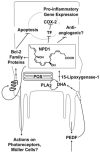Neurotrophins induce neuroprotective signaling in the retinal pigment epithelial cell by activating the synthesis of the anti-inflammatory and anti-apoptotic neuroprotectin D1
- PMID: 18188926
- PMCID: PMC2645073
- DOI: 10.1007/978-0-387-74904-4_3
Neurotrophins induce neuroprotective signaling in the retinal pigment epithelial cell by activating the synthesis of the anti-inflammatory and anti-apoptotic neuroprotectin D1
Abstract
The integrity of retinal pigment epithelial cells is critical for photoreceptor cell survival and vision. The essential omega-3 fatty acid, docosahexaenoic acid, attains its highest concentration in the human body in photoreceptors. Docosahexaenoic acid is the essential precursor of neuroprotectin D1 (NPD1). NPD1 acts against apoptosis mediated by A2E, a byproduct of phototransduction that becomes toxic when it accumulates in aging retinal pigment epithelial (RPE) cells and in some inherited retinal degenerations. Here we also describe that neurotrophins, mainly pigment epithelium-derived factor, induce NPD1 synthesis and its polarized apical secretion, suggesting paracrine and autocrine bioactivity of this lipid mediator. In addition, DHA elicits a concentration-dependent and selective potentiation of pigment epithelial-derived factor-stimulated NPD1 synthesis and release through the apical RPE cell surface. The bioactivity of signaling activated by PEDF and DHA demonstrates synergistic cytoprotection when cells were challenged with oxidative stress, resulting in concomitant NPD1 synthesis. Also, DHA and PEDF synergistically activate anti-apoptotic protein expression and decreased pro-apoptotic Bcl-2 protein expression and caspase 3 activation during oxidative stress. Thus, DHA-derived NPD1 protects against RPE cell damage mediated by aging/disease-induced A2E accumulation. Also, neurotrophins are regulators of NPD1 synthesis and of its polarized apical efflux from RPE cells. Therefore, NPD1 may elicit autocrine and paracrine bioactivity in cells located in the proximity of the interphotoreceptor matrix.
Figures

References
-
- Bazan NG. Cell survival matters: docosahexaenoic acid signaling, neuroprotection and photoreceptors. Trends Neurosci. 2006;29:263. - PubMed
-
- Bui TV, Han Y, Radu RA, Travis GH, Mata NL. Characterization of native retinal fluorophores involved in biosynthesis of A2E and lipofuscin-associated retinopathies. J Biol Chem. 2006;281:18112. - PubMed
-
- Cideciyan AV, Aleman TS, Swider M, Schwartz SB, Steinberg JD, Brucker AJ, Maguire AM, Bennett J, Stone EM, Jacobson SG. Mutations in ABCA4 result in accumulation of lipofuscin before slowing of the retinoid cycle: a reappraisal of the human disease sequence. Hum Mol Genet. 2004;13:525. - PubMed
-
- Hu J, Bok D. A cell culture medium that supports the differentiation of human retinal pigment epithelium into functionally polarized monolayers. Mol Vis. 2001;7:14. - PubMed
Publication types
MeSH terms
Substances
Grants and funding
LinkOut - more resources
Full Text Sources
Research Materials
Miscellaneous

